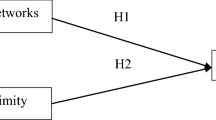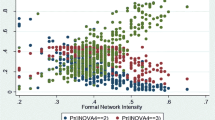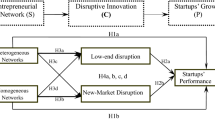Abstract
Research on how start-up firms utilize networks has focused on direct effects of either the personal network around the entrepreneur or the formal collaboration network around the firm. Combining those approaches, we model how a firm’s collaboration network is embedded in the personal network around the entrepreneur. With data from the Global Entrepreneurship Monitor on 8918 start-up firms in 40 countries surveyed during 2012–2013, we examine (1) how entrepreneurs’ networking in private and public spheres is impacting firms’ collaborative networking, (2) how both the personal network and the firm network are impacting performance in forms of innovation and exporting, and (3) how embeddedness of the firm network in the private and public sphere networks around the entrepreneur is affecting innovation and export. The analyses show that the firm network as well as innovation and export are enhanced by the networking in the public sphere, but reduced by networking in the private sphere. Moreover, the benefits of firm network for innovation and export are strengthened by networking in the public sphere but weakened by networking in the private sphere. Finally, we find that innovation is a driver for export, and that this benefit is enhanced by networking in the public sphere, but decreases with networking in the private sphere. These findings refine our knowledge of the functioning of firms’ networking for innovation, especially the positive effects of networking in the public sphere and negative effects of networking in the private sphere.



Similar content being viewed by others
References
Adler Paul S, Kwon S-W (2002) Social Capital: prospects for a new concept. Acad Manag Rev 27(1):17–40. doi:10.5465/AMR.2002.<strongxmlns:translation=“urn:EBSCO-Translation”>5922314</strong>
Ahuja G (2000) Collaboration networks, structural holes, and innovation: a longitudinal study. Adm Sci Q 45(3):425–455
Ashourizadeh S, Schøtt T (2015) Exporting embedded in culture and transnational networks around entrepreneurs: A global study. Int J Bus Glob (forthcoming)
Ashourizadeh S, Rezaei S, Schott T, Vang J (2014) Entrepreneurs’ human and social capital: direct and reinforcing benefits for export. Int J Entrep Small Bus 21(2):246. doi:10.1504/IJESB.2014.059476
Audretsch DB, Keilbach MC, Lehmann EE (2006) Entrepreneurship and economic growth. Oxford University Press, New York
Baum JAC, Oliver C (1996) Toward an institutional ecology of organizational founding. Acad Manag J 39(5):1378–1427. doi:10.2307/257003
Bosma N, Coduras A, Litovski Y, Seaman J (2012) A report on the design, data and quality control of the Global Entrepreneurship Monitor
Boso N, Story VM, Cadogan JW, Micevski M, Kadić-Maglajlić S (2013) Firm innovativeness and export performance: environmental, networking, and structural contingencies. J Int Market 21(4):62–87
Burt RS (2000) The network structure of social capital. Res Organ Behav 22:345–423. doi:10.1016/S0191-3085(00)22009-1
Cassiman B, Golovko E (2010) Innovation and internationalization through exports. J Int Bus Stud 42(1):56–75. doi:10.1057/jibs.2010.36
Cheraghi M, Schott T (2014) Size, diversity and components in the network around an entrepreneur: shaped by culture and shaping embeddedness of firm relations. In Can F, Özyer T, Polat F (eds) State of the art applications of social network analysis. Springer, Cham, pp 339–358. doi:10.1007/978-3-319-05912-9
Cheraghi M, Schøtt T (2015) Conceived globals: Entrepreneurs’ transnational networking, across phases and embedded in culture. Int J Bus Glob. doi:10.1108/IJGE-03-2013-0027
Dai O, Liu X (2009) Returnee entrepreneurs and firm performance in Chinese high-technology industries. Int Bus Rev 18(4):373–386. doi:10.1016/j.ibusrev.2009.03.004
Davidsson P, Honig B (2003) The role of social and human capital among nascent entrepreneurs. J Bus Ventur 18(3):301–331. doi:10.1016/S0883-9026(02)00097-6
Drori I, Honig B, Wright M (2009) Transnational Entrepreneurship: an emergent field of study. Entrep Theory Pract 33(5):1001–1022. doi:10.1111/j.1540-6520.2009.00332.x
Dubini P, Aldrich H (1991) Personal and extended networks are central to the entrepreneurial process. J Bus Ventur 6(5):305–313. doi:10.1016/0883-9026(91)90021-5
Elfring T, Hulsink W (2007) Networking by entrepreneurs: patterns of tie formation in emerging organizations. Organ Stud 28(12):1849–1872. doi:10.1177/0170840607078719
Evald MR, Klyver K, Christensen PR (2011) The effect of human capital, social capital, and perceptual values on nascent entrepreneurs’ export intentions. J Int Entrep 9(1):1–19. doi:10.1007/s10843-010-0069-3
Fernhaber SA, Li D (2013) International exposure through network relationships: implications for new venture internationalization. J Bus Ventur 28(2):316–334. doi:10.1016/j.jbusvent.2012.05.002
Fernhaber SA, Mcdougall-Covin PP, Shepherd DA (2009) International entrepreneurship: leveraging internal and external knowledge sources. Strateg Entrep J 3(4):297–320. doi:10.1002/sej.76
Filatotchev I, Liu X, Buck T, Wright M (2009) The export orientation and export performance of high-technology SMEs in emerging markets: the effects of knowledge transfer by returnee entrepreneurs. J Int Bus Stud 40(6):1005–1021. doi:10.1057/jibs.2008.105
Gargiulo M, Benassi M (2000) Trapped in your own net? Network cohesion, structural holes, and the adaptations of social capital. Organ Sci 11(2):183–196
Goerzen A (2007) Alliance networks and firm performance: the impact of repeated partnerships. Strateg Manag J 28(5):487–509. doi:10.1002/smj.588
Granovetter M (1985) Economic action and social structure: the problem of embeddedness. Am J Sociol 91(3):481–510
Guan J, Ma N (2003) Innovative capability and export performance of Chinese firms. Technovation 23(9):737–747. doi:10.1016/S0166-4972(02)00013-5
Hessels J, Terjesen S (2008) Resource dependency and institutional theory perspectives on direct and indirect export choices. Small Bus Econ 34(2):203–220. doi:10.1007/s11187-008-9156-4
Hilmersson M (2012) Reducing uncertainty in the emerging market entry process: on the relationship among international experiential knowledge, institutional distance, and uncertainty. J Int Market 20(4):96–110
Hite JM (2005) Evolutionary processes and paths of relationally embedded network ties in emerging entrepreneurial firms. Entrep Theory Pract 29(1):113–144. doi:10.1111/j.1540-6520.2005.00072.x
Hite JM, Hesterly WS (2001) The evolution of firm networks: from emergence to early growth of the firm. Strateg Manag J 22(3):275–286. doi:10.1002/smj.156
Hoang H, Antoncic B (2003) Network-based research in entrepreneurship. J Bus Ventur 18(2):165–187. doi:10.1016/S0883-9026(02)00081-2
Huang H-C, Lai M-C, Lo K-W (2012) Do founders’ own resources matter? The influence of business networks on start-up innovation and performance. Technovation 32(5):316–327. doi:10.1016/j.technovation.2011.12.004
Jarillo JC (1988) On strategic networks. Strateg Manag J 9(1):31–41. doi:10.1002/smj.4250090104
Jensen KW, Schøtt T (2014) Firms’ innovation embedded in their networks of collaboration: China compared to the world. J Chin Econ Bus Stud 12(3):273–292. doi:10.1080/14765284.2014.931427
Johanson J, Vahlne J-E (2009) The Uppsala internationalization process model revisited: from liability of foreignness to liability of outsidership. J Int Bus Stud 40(9):1411–1431. doi:10.1057/jibs.2009.24
Klyver K, Terjesen Siri (2007) Entrepreneurial network composition: an analysis across venture development stage and gender. Women Manag Rev 22(8):682–688. doi:10.1108/09649420710836344
Manolova TS, Manev IM, Gyoshev BS (2010) In good company: the role of personal and inter-firm networks for new-venture internationalization in a transition economy. J World Bus 45(3):257–265. doi:10.1016/j.jwb.2009.09.004
Milanov H, Shepherd DA (2013) The importance of the first relationship: the ongoing influence of initial network on future status. Strateg Manag J 34(6):727–750. doi:10.1002/smj.2109
Musteen M, Francis J, Datta DK (2010) The influence of international networks on internationalization speed and performance: a study of Czech SMEs. J World Bus 45(3):197–205. doi:10.1016/j.jwb.2009.12.003
Nahapiet J, Ghoshal S (1998) Social capital, intellectual capital, and the organizational advantage. Acad Manag Rev 23(2):242–266. doi:10.5465/AMR.1998.<strongxmlns:translation=“urn:EBSCO-Translation”>533225</strong>
Newbert SL, Tornikoski ET (2010) Supporter networks and network growth: a contingency model of organizational emergence. Small Bus Econ 39(1):141–159. doi:10.1007/s11187-010-9300-9
Oviatt BM, McDougall PP (2005) Defining international entrepreneurship and modeling the speed of internationalization. Entrep Theory Pract 29(5):537–554. doi:10.1111/j.1540-6520.2005.00097.x
Patel PC, Fernhaber SA, McDougall-Covin PP, van der Have RP (2014) Beating competitors to international markets: the value of geographically balanced networks for innovation. Strateg Manag J 35(5):691–711. doi:10.1002/smj.2114
Phelps C, Heidl R, Wadhwa A (2012) Knowledge, networks, and knowledge networks: a review and research agenda. J Manag 38(4):1115–1166. doi:10.1177/0149206311432640
Pittaway L, Robertson M, Munir K, Denyer D, Neely A (2004) Networking and innovation: a systematic review of the evidence. Int J Manag Rev 5–6(3–4):137–168. doi:10.1111/j.1460-8545.2004.00101.x
Portes A, Sensenbrenner J (2003) Embeddedness and Immigration: notes on the social determinants of economic action. Am J Sociol 98(6):1320–1350
Powell WW, Koput KW, Smith-Doerr L (1996) Interorganizational collaboration and the locus of innovation: networks of learning in biotechnology. Adm Sci Q 41(1):116–145
Raudenbush SW, Bryk AS (2002) Hierarchical linear models: applications and data analysis methods, 2nd edn. SAGE Publications, New York
Reynolds P, Bosma N, Autio E, Hunt S, De Bono N, Servais I, Chin N (2005) Global entrepreneurship monitor: data collection design and implementation 1998? 2003. Small Bus Econ 24(3):205–231. doi:10.1007/s11187-005-1980-1
Roper S, Love JH (2002) Innovation and export performance: evidence from the UK and German manufacturing plants. Res Policy 31(7):1087–1102. doi:10.1016/S0048-7333(01)00175-5
Saxenian A (2002) Transnational communities and the evolution of global production networks: the cases of Taiwan, China and India. Ind Innov 9(3):183–202. doi:10.1080/1366271022000034453
Schøtt T (2014) Components of the network around an actor. In: Alhajj R, Rokne J (eds) Encyclopedia of social network analysis and mining. Springer, New York. doi:10.1007/978-1-4614-6170-8
Schott T, Sedaghat M (2014) Innovation embedded in entrepreneurs’ networks and national educational systems. Small Bus Econ 43(2):463–476. doi:10.1007/s11187-014-9546-8
Slotte-Kock S, Coviello N (2010) Entrepreneurship research on network processes: a review and ways forward. Entrep Theory Pract 34(1):31–57. doi:10.1111/j.1540-6520.2009.00311.x
Stam W, Arzlanian S, Elfring T (2014) Social capital of entrepreneurs and small firm performance: a meta-analysis of contextual and methodological moderators. J Bus Ventur 29(1):152–173. doi:10.1016/j.jbusvent.2013.01.002
Sterlacchini A (1999) Do innovative activities matter to small firms in non-R&D-intensive industries? An application to export performance. Res Policy 28(8):819–832. doi:10.1016/S0048-7333(99)00023-2
Stinchcombe AL (1965) Social structure and organizations. In: Handbook of organizations, pp 142–193
Sullivan Mort G, Weerawardena J (2006) Networking capability and international entrepreneurship: how networks function in Australian born global firms. Int Mark Rev 23(5):549–572
Tomiura E (2009) Foreign versus domestic outsourcing: firm-level evidence on the role of technology. Int Rev Econ Finance 18(2):219–226. doi:10.1016/j.iref.2008.06.001
Uzzi B (1997) Social structure and competition in interfirm networks: the paradox of embeddedness. Adm Sci Q 42(1):35–67
Wang Q, Liu CY (2014) Transnational activities of immigrant-owned firms and their performances in the USA. Small Bus Econ. doi:10.1007/s11187-014-9595-z
Westhead P, Wright M, Ucbasaran D (2001) The internationalization of new and small firms. J Bus Ventur 16(4):333–358. doi:10.1016/S0883-9026(99)00063-4
Xie YH, Suh T (2014) Perceived resource deficiency and internationalization of small- and medium-sized firms. J Int Entrep 12(3):207–229. doi:10.1007/s10843-014-0121-9
Yiu DW, Lau C, Bruton GD (2007) International venturing by emerging economy firms: the effects of firm capabilities, home country networks, and corporate entrepreneurship. J Int Bus Stud 38(4):519–540. doi:10.1057/palgrave.jibs.8400278
Zahra SA (2004) A theory of international new ventures: a decade of research. J Int Bus Stud 36(1):20–28. doi:10.1057/palgrave.jibs.8400118
Zeng SX, Xie XM, Tam CM (2010) Relationship between cooperation networks and innovation performance of SMEs. Technovation 30(3):181–194. doi:10.1016/j.technovation.2009.08.003
Zhou L, Wu W, Luo X (2007) Internationalization and the performance of born-global SMEs: the mediating role of social networks. J Int Bus Stud 38(4):673–690. doi:10.1057/palgrave.jibs.8400282
Acknowledgments
The data were collected in the Global Entrepreneurship Monitor. We are grateful to the Danish Industry Foundation, Industriens Fond, for financial support and to colleagues in the GEM consortium for surveys; the responsibility for analyses, and interpretations rests with the authors.
Author information
Authors and Affiliations
Corresponding author
Rights and permissions
About this article
Cite this article
Jensen, K.W., Schott, T. Start-up firms’ networks for innovation and export: facilitated and constrained by entrepreneurs’ networking in private and public spheres. Soc. Netw. Anal. Min. 5, 48 (2015). https://doi.org/10.1007/s13278-015-0287-8
Received:
Revised:
Accepted:
Published:
DOI: https://doi.org/10.1007/s13278-015-0287-8




